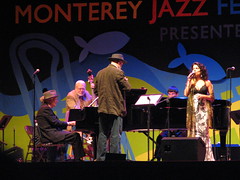Truth In Advertising - Jazz Edition
With that out of the way, let's proceed to talk about this interesting "new " CD - "Ray Sings, Basie Swings". Ray passed away in June 2004, shortly before the release of his "final" studio album, "Genius Loves Company" which came out in August of that year. A hit by any definition of the term, the album stood for weeks in Billboards Top 10 list (not for jazz or r&b, but Top 10 overall) and debuted at No. 2 on the chart. It shipped over 3 million copies and that figure is likely to rise even more, due to the brilliant marketing from Concord Records and Starbucks Corp's Hear Music division. It has become Ray's best selling album (eclipsing even his great sides for Atlantic and ABC in his prime).
Naturally, the industry was paying attention, and Charles estate was as well. In 2005, Rhino Records released a CD called "Genius and Friends" - an attempt to salvage an aborted session Ray did in the late 1990's, in more of a pop vein. They went back to the master tapes, removed many of the "duet" partners who were part of the original project, and put in folks like Reuben Studdard, (who as far as I know, never even met Ray in his lifetime). The project wasn't nearly as well crafted as "Genius Loves Company" (it was really rather mundane adult contemporary material) nor did it have the Starbucks machine behind it. It didn't sell nearly as well as "Company".
Now, the folks at Starbucks and Concord are back, with their own take on a posthumous collaboration - "Ray Sings, Basie Swings". Musically of the three albums discussed in this post, it's probably the best. Ray is at his peak as a performer. It swings hard, and at times, Ray is simply on FIRE! But things aren't quite what they seem:
Count Basie isn't on the album. His band is, but it's directed by Bill Hughes. And Ray never actually recorded with the band. Ray's vocals on the CD are taken from Jazz at the Philharmonic tapes made by Norman Granz from the 1970's. Supposedly they were marked "Ray Charles/Count Basie" but featured separate performances by the artists. And also according to Greg Fields who produced this new CD, the instrumental backing on the tapes featuring Ray were recorded poorly (oddly, most of the 1970's live Granz recordings I've heard have been pretty decent, who knows).
So the producers got the idea to commission new arrangements (based on Ray's originals) to be performed by the 2005/2006 edition of the Count Basie Orchestra. They would take Ray's 1970's vocals, isolate them from the originals by removing the band backing him and mix them with the new "Basie" performances. Tom Scott, Shelly Berg and others penned the charts. And they did a pretty good job. Some of the tracks come off better than others, but overall, it's one of the better attempts at this sort of studio wizardry I've heard. The producers make the point that Ray loved technology, and would often overdub parts, in much the same manner that this album was created.
Ok, I know some purists have a problem with that. I'm a little less than sold on the concept, but like I said, Ray's vocals are A+ quality, so I'll give a little lee-way on that issue. The thing I have a problem with is the name of the album, and the false impression it gives the consumer. The title is "Ray Sings, Basie Swings" Subtitled Ray Charles + The Count Basie Orchestra = Genius2 (squared). The subtitle is ok, as the Basie band's albums since the Count's death have all been listed as "The Count Basie Orchestra", where as in Basie's lifetime, it was usually "Cont Basie and his Orchestra". But when you say "Ray Sings, Basie Swings" and then talk about this great collaboration between two great artists, the implication is that the man from Red Bank, NJ, Bill Basie, is ON the CD. But he's not. "Ray" refers to an individual, but somehow we're supposed to infer that "Basie" refers to "Basie Inc" and not the man himself? When I first saw this CD I was very excited, thinking it was some long lost session featuring the two men together, I was less excited after reading what it really was, though still pleased with much of the music.
Here's the kicker, the press materials talked about how this was a great pairing that never happened in "real life" but thanks to the benefit of technology, we now can enjoy on CD. Yes, it is true that Ray never recorded with Basie's band under Basie's name. But one of his GREATEST all time albums, though one that admittedly doesn't feature much of Ray's singing, actually was recorded with Basie's group, minus the Count "Genius + Soul = Jazz." Quincy Jones did the arrangements, Ray plays keyboards. It's as close to a real Charles/Basie collaboration as we'll ever get. Though the record store bin might lead one to think otherwise.




